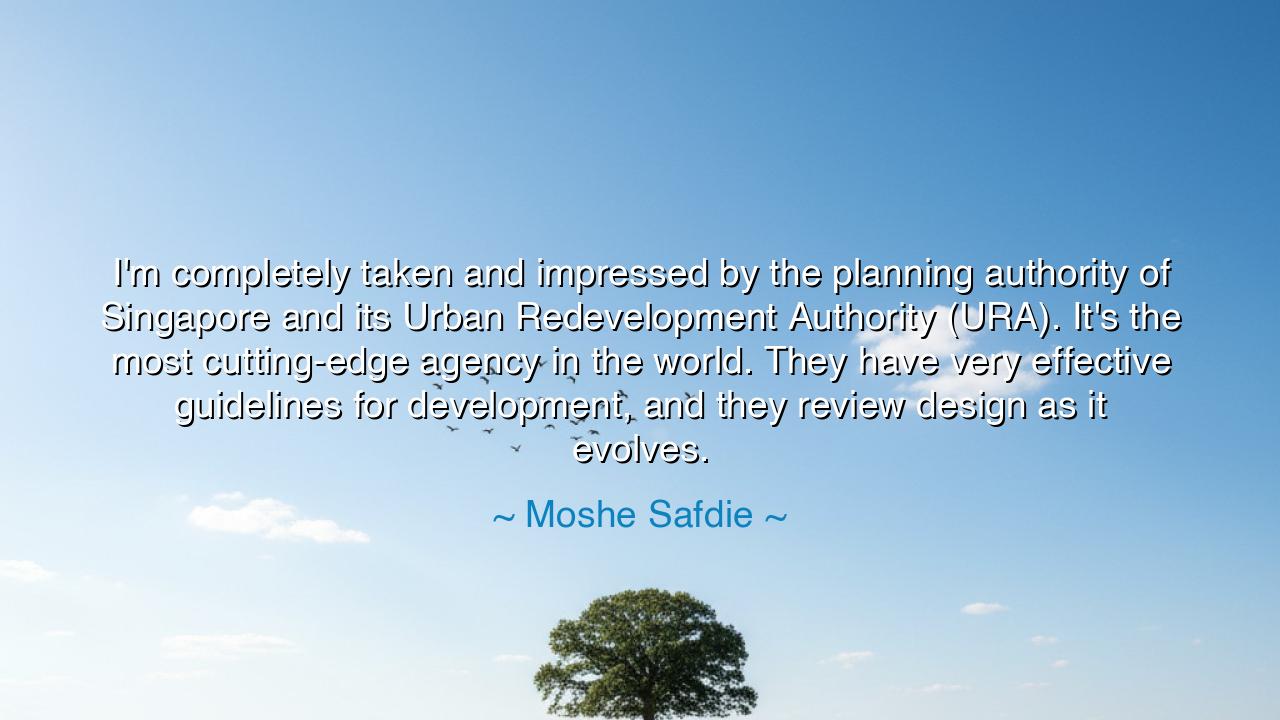
I'm completely taken and impressed by the planning authority of
I'm completely taken and impressed by the planning authority of Singapore and its Urban Redevelopment Authority (URA). It's the most cutting-edge agency in the world. They have very effective guidelines for development, and they review design as it evolves.






“I’m completely taken and impressed by the planning authority of Singapore and its Urban Redevelopment Authority (URA). It’s the most cutting-edge agency in the world. They have very effective guidelines for development, and they review design as it evolves.” Thus spoke Moshe Safdie, the architect whose works have long sought to unite beauty with purpose, and humanity with its built environment. His words are not mere praise for a city’s administration—they are a meditation on visionary design, on the sacred balance between freedom and structure, and on how true progress is born not from chaos, but from conscious creation. In his reflection upon Singapore, Safdie reminds us that civilization, like architecture, must be both planned and alive, disciplined in its structure yet flexible in its spirit.
To understand Safdie’s admiration, one must understand both the man and the city. Moshe Safdie, born in Haifa and raised amidst the complexities of a newly forming Israel, grew to see architecture not merely as shelter, but as a vessel for human dignity. His designs—Habitat 67, the Marina Bay Sands, and countless others—reflect his eternal pursuit of harmony between individual experience and communal vision. Singapore, too, was born from necessity and imagination. A small island with no natural wealth but a great hunger for order and progress, it transformed itself within a generation from chaos to brilliance. The Urban Redevelopment Authority (URA) became its guiding hand—an institution that treated urban growth not as accident, but as art.
In his praise, Safdie acknowledges what few understand: that good design is not the enemy of rules, but their rightful child. The URA does not impose limits to stifle creativity; rather, it builds frameworks that guide innovation. Its guidelines are not chains, but paths—clear enough to prevent disorder, open enough to invite genius. When Safdie calls it “the most cutting-edge agency in the world,” he honors its wisdom: that planning, when done with vision and reverence, can elevate both the city and the soul. It is this balance that transforms mere construction into civilization.
Throughout history, great cities have always been born of great minds who understood this balance. Athens, in the age of Pericles, was not built by chance, but by principle—its temples aligned to the heavens, its streets open to the sun, its philosophy embodied in its form. Rome, too, grew not only through conquest, but through planning—its roads and aqueducts linking the empire in both order and spirit. Yet where those empires eventually fell to their own excess and neglect, Singapore endures, for it continues to review design as it evolves, as Safdie says. The city is not frozen perfection; it is a living organism, ever refining itself in the dialogue between past and future.
There is wisdom here that transcends architecture. For Safdie’s words, though spoken of city planning, are truly about human design. Just as a city must evolve while remaining true to its core, so too must we plan the architecture of our own lives. To live well is to balance freedom with discipline, ambition with humility, and creativity with purpose. Without a plan, we drift; without openness, we stagnate. The wise individual, like the wise architect, must design their life as Singapore designs its skyline—with care, intention, and courage to adapt when new challenges arise.
Safdie’s insight also calls upon us to redefine progress. In a world that too often mistakes speed for advancement, he points us toward the quality of growth—growth that uplifts, beautifies, and sustains. The URA’s success lies not in its ambition to build endlessly, but in its devotion to harmony: between the natural and the man-made, the practical and the poetic. This is the same harmony Safdie has sought in all his works, a reminder that every great design must honor both human need and the eternal landscape.
Thus, the lesson of Moshe Safdie’s words is not limited to architects or planners—it belongs to all who build, create, or lead. Whether one shapes a building, a community, or a destiny, one must do so with both vision and discipline, both guidance and grace. Let us, then, be like Singapore—bold in imagination, deliberate in execution, and humble enough to evolve. Let us treat every act of creation as a sacred trust between the mind that conceives and the world that receives.
For in the end, as Safdie teaches, the highest form of design—whether of city or soul—is not to dominate, but to harmonize. It is to build in such a way that the structure breathes, that progress serves people, and that every rising tower, like every rising life, becomes an offering to both beauty and order, both freedom and responsibility. Then, and only then, can our creations—like Singapore’s skyline—stand as monuments not just of power, but of wisdom enduring through time.






AAdministratorAdministrator
Welcome, honored guests. Please leave a comment, we will respond soon